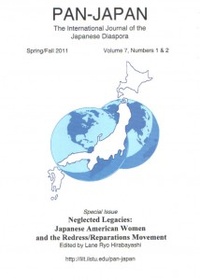In the 2011 PAN-JAPAN special issue NEGLECTED LEGACIES: Japanese American Women and the Redress/Reparations Movement, guest editor Lane Ryo Hirabayashi, an Asian American studies professor at UCLA (where he is also the George & Sakaye Aratani chair in Japanese American Incarceration, Redress, and Community), acknowledges that in (resourcefully) editing the papers comprising Neglected Legacies and in writing up his published (and very perceptive) introduction to them, he benefitted from his interactions with three notable Sansei activists.
One of these third-generation Nikkei, Grant Ujifusa, was a key national player in the Japanese American redress movement that culminated in the Civil Liberties Act of 1988. The legislation awarded monetary damages to the survivors among the 120,000 American victims of Japanese ancestry whom the U.S. government forcibly imprisoned in concentration camps during World War II. Indeed, on January 26, 2012, the Japanese government bestowed upon Ujifusa the Order of the Rising Sun, Gold and Silver Rays, the equivalent of a knighthood, for his pivotal role, as redress strategy chair for the Japanese American Citizen League, both for developing a justification for redress that appealed to liberals and conservatives alike in the 1980s Congress and for his behind-the-scenes, 11th-hour stage management that helped persuade President Ronald Reagan to reverse his public opposition to the redress bill, which he signed into law on August 10, 1988.
In formally accepting his high honor, Ujifusa was silent about his own part in the success of redress, choosing instead to champion the consequential activities of six other Nikkei, including two comparatively unheralded second-generation women (Seattle small business woman Cherry Kinoshita and Philadelphia social worker Grayce Uyehara). Lauding them as people for who redress was total isshou kenmei, full-throttle and non-stop, Ujifusa emphasized that without these six individuals the effort to secure Japanese American redress would have failed.
As far back as summer 2008 Ujifusa struck a very similar note in a Nichi Bei Times commentary, reminding readers of the indispensable redress contributions made by individuals at the time marginalized and nearly forgotten. More specifically, Ujifusa would later observe in a Hokubei Mainichi opinion piece that Nisei women, such as Cherry Kinoshita and Grayce Uyehara, were at the core of redress in Japanese American communities, since they were often more willing than Nisei or Sansei men to lobby the issue in face-to-face encounters with politicians, not only on the West Coast, but all over the country. This observation led Lane Hirabayashi to encourage Ujifusa to write a semi-academic piece on this topic, to which he replied, “Lane, you do it.”
The impressive edited anthology under review here confirms that Hirabayshi accepted Ujifusa’s challenge in full measure. Consisting of two substantial historical monographs (Elissa Kikuye Ouchida’s “Nisei Employees vs. California State Personnel Board: A Journal of Ex Parte Endo, 1942-1947” and Susan Nakaoka’s “‘Typical’ Nisei: An Intersectional Approach to Interpreting the Lives of Five Japanese American Women Activists”), one short commemorative biography (Phillip Tajitsu Nash, “Michi Nishiura Weglyn: A Friend’s Reflections, a Decade Later”), and a modest-sized oral history interview (Edna Horiuchi’s “An Interview with Lillian Nakano: Sansei Artist and Activist”), Neglected Legacies certainly qualifies as a semi-academic work. As such, it is consonant with PAN-JAPAN’s statement of purpose, most particularly its avowed interest “in occasional pieces that do not fit the strict definition of academic discourse…(since they) can sometimes tell stories that scholarly articles cannot.” What makes the combination of mixed-genre contributions to this anthology so laudable is their inter-textual compatibility. In short, they all work toward the same end in a manner that ensures that the work’s value as a whole exceeds the mere sum of its parts.
In his preface, Don Nakanishi, the UCLA Asian American Studies Center’s distinguished former director, captures this purpose when he writes that “the articles (in Neglected Legacies) do far more than highlight and analyze the indispensable roles that Nisei women played during one of the most significant periods in Japanese American history. They also provide us with detailed, nuanced accounts of the compelling ‘back stories’—personal histories and private beliefs and motives—behind the actions they took.”
While all of the stunning selections in Neglected Legacies are noteworthy in terms of redeeming the promissory note suggested by Ujifusa and brought to fruition by Hirabayashi, the jewel in this anthology’s crown is assuredly the Susan Nakaoka article. For in it, she deftly employs the multi-dimensional theory of “intersectionality,” which is that “the fact that race, gender, class, culture, immigration status, and other ‘identity’ create a unique confluence that shapes how women of color experience the world,” to understand, via in-depth oral history interviews, the emergence during the 1980s of five second-generation and third-generation Nikkei women activists (Sue Kunitomi Embrey, Chizu Iiyama, Cherry Kinoshita, Chiye Tomihiro, and Grayce Uyehara) as leaders of the Japanese American Redress Movement. It is fervently hoped that this very significant article, adopted by Nakaoka from her UCLA master’s thesis, will become the basis for a published book.
* * *
NEGLECTED LEGACIES: Japanese American Women and the Redress/Reparations Movement
Edited by Lane Ryo Hirabayashi
Special issue of “PAN-JAPAN: The International Journal of the Japanese Diaspora” Normal, Ill.: (Spring/Fall 2011: Volume 7, Numbers 1 & 2, 197 pp., $12.50, paperback)
Purchase information available at http://lilt.ilstu.edu/pan-japan
*This article was originally published in the Nichi Bei Weekly on July 25, 2013.
© 2013 Arthur A. Hansen / Nichi Bei Weekly








